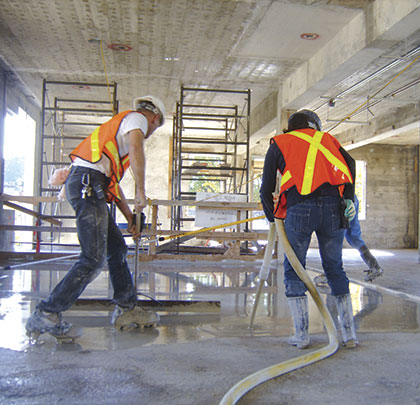The United States Army Corp of Engineers (USACE) Engineering Manual 385-1-1, Safety and Health Requirements Manual, 2014 version is out. Compliance with the EM 385-1-1 is required by nearly all contractors working on military contracts engaged in construction, dismantling, and demolition operations, and has been in place nearly 30 years prior to the enactment of OSHA. This includes those contractors working on U.S. Army Corps of Engineers, Naval Facilities Engineering Command (NAVFAC), Department of Defense (DoD), and other various government agency contracts. NAVFAC, in particular, has been instrumental in its ongoing work with USACE in the development and effectiveness of the EM385-1-1.
Contractors need to be keenly aware of the requirements and associated underlined revisions of the new 950-page, 34-section document. What’s triggered the need for the recent revisions? The USACE has reported that poor planning, increased injuries, and lack of proper documentation were some of the driving factors. Many questions are popping up from contractors across the country about the new version, and two key sections seem to generate the most inquiries.
SECTION 1: PROGRAM MANAGEMENT
Revisions to this section include edits to Indoctrination and Training, Physical Qualifications of Employees, Mishap Reporting and Investigation, Emergency Planning, Emergency Operations, Explosives Activities and Operations. Contractors need to pay special attention to the requirements regarding three key documents:
- A written, site-specific Accident Prevention Plan (APP) that describes the management processes to prevent accidents.
- A documented and detailed Position Hazard Analysis (PHA) for each key position according to the hazards associated with the position’s tasks.
- A documented and detailed Activity Hazard Analysis (AHA) that identifies tasks, potential hazards, and control strategies.
The next eye opener is the requirement of key safety personnel. With respect to the APP, PHA, and AHA, these positions include:
- Site Safety and Health Officer (SSHO): The superintendent or other qualified or competent person who is responsible for on-site safety and health.
- Site Safety and Health Officer/Hazardous Toxic Radioactive Waste (HTRW): The person on-site with the responsibility for implementation of the APP and Site Safety & Health Plan (SSHP) appendix for HTRW activities.
- Safety and Health Manager (SHM): The Certified Industrial Hygienist (CIH), Certified Safety Professional (CSP), or Certified Health Physicist (CHP) responsible for development and enforcement of the APP and SSHP appendix for HTRW activities.
- Collateral Duty Safety Officer (CDSO): An employee who is trained to assist with the Safety & Occupational Health (SOH) program as a minor duty (20 percent or less of the time).
- Designated Representative (DR): An individual that can substitute for an SSHO under certain conditions.
TRAINING REQUIREMENTS
Revisions surrounding an SSHO’s education and experience are also detailed in the manual. Training requirements include a 30-hour OSHA Construction or General Industry safety class or equivalent training, including safety and health training covering the subjects of the OSHA 30-hour course and EM 385-1-1. There is also an annual 8-hour competency training requirement.
SSHO experience includes 5 years of continuous construction industry safety experience in supervising/ managing general construction. If the SSHO holds a third-party, nationally accredited SOH-related certification, such as CSP, OHST, CHST, or STS, only 4 years of experience is needed.
And speaking of training, contractors must pay careful attention to two key statements: 1) All training shall correspond to American National Standards Institute (ANSI) Z490.1- Criteria for Accepted Practices in Safety, Health, and Environmental Training. This is a critical consensus document that details the hierarchy of instructional program design and adult learning principals by which any trainer or training organization shall—and should—be measured; and 2) The local SOHO (Safety & Occupational Health Office), having jurisdiction over the work, shall evaluate the proposed equivalent training for applicability to the contract work to be performed. Bottom line, no matter where training was procured, the SOHO reserves the final authority to approve or reject training.
And the final honorable mention to Section 1 is the addition of requirements for fatigue management planning. A Fatigue Management Plan must identify affected workers, management responsibility, training, and controls established at the worksite, especially for those operating equipment, machinery, and vehicles. There are also work hour maximum guidelines for reference.
SECTION 21: FALL PROTECTION
Falls are the leading cause of fatalities in construction each year. The EM 385-1-1 has taken drastic measures to reduce those numbers. Contractors need to pay careful attention to the new training requirements which include a mandated minimum of 24 hours, with a suggested combination of at least 16 hours of formal classroom training and 8 hours of practical application for Program Administrators and Managers, Qualified Persons (QP), Competent Persons, End Users (i.e., Authorized Persons), Authorized Rescuers, as well as any associated FP trainers. Training shall be performed by a Competent Person (CP) or a Qualified Person (QP) conforming to the requirements of ANSI Z359.2 and ANSI Z490.1.
BEING IN THE KNOW
There are significant revisions to the EM 385-1-1. Knowledge and training on these new revisions will promote compliance within your organization to prevent injury, illness, mishaps, related risk, and the potential for job shutdowns. Contractors need to work closely with their DoD contract Safety and Occupational Health (SOH) contacts. ■
About The Author: Paul J. Colangelo, STS-C, CHST, CET, a 16-year accredited OSHA Outreach 10- and 30-hour construction program trainer, currently serves as the National Director of Compliance Programs for ClickSafety.com. He has 25 years of experience as an EHS director, manager, and consultant to the construction, telecommunications, and utility and renewable energy sectors. Mr. Colangelo has written numerous safety-based articles for national publications and attends and speaks at national events.
_________________________________________________________________________
Modern Contractor Solutions, October 2015
Did you enjoy this article?
Subscribe to the FREE Digital Edition of Modern Contractor Solutions magazine.



